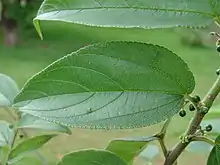Trema micrantha
Trema micrantha, the Jamaican nettletree[2] or capulin,[3] is a plant species native to warmer parts of the Western Hemisphere. It has been reported from Mexico, Central America, Bolivia, Argentina, Colombia, Ecuador, French Guiana, the Virgin Islands, Guyana, Venezuela, Suriname, Peru, Paraguay, Jamaica, Cuba, Hispaniola, Puerto Rico, and southern Florida.[4][5] In Florida, it has been collected in 10 of the state's southern counties.[6][7]
| Trema micrantha | |
|---|---|
 | |
| In Brasília | |
| Scientific classification | |
| Kingdom: | Plantae |
| Clade: | Tracheophytes |
| Clade: | Angiosperms |
| Clade: | Eudicots |
| Clade: | Rosids |
| Order: | Rosales |
| Family: | Cannabaceae |
| Genus: | Trema |
| Species: | T. micrantha |
| Binomial name | |
| Trema micrantha (L.) Blume | |
| Synonyms[1] | |
| |
Description
Trema micrantha is a shrub or small tree up to 10 m tall. Leaves are egg-shaped, up to 9 cm long, green on top but covered with white, woolly pubescence underneath. Flowers are greenish-white. Fruits are yellow to bright reddish-range, up to 4 mm in diameter. [4][8][9]
Uses
Following the recent local extirpation of slow-growing xalama in San Pablito, Mexico due to unsustainable harvesting driven by tourism, the Otomi people now use Trema micrantha bark strips as a raw material for making handmade amate paper.[10]
References
- The Plant List, Trema micrantha"
- "Trema micratha". Natural Resources Conservation Service PLANTS Database. USDA. Retrieved 14 December 2015.
- "Trema micrantha". Germplasm Resources Information Network (GRIN). Agricultural Research Service (ARS), United States Department of Agriculture (USDA). Retrieved 5 September 2020.
- Flora of North America vol 3 Trema micrantha'
- Tropicos, Trema micrantha, distribution
- USDA Natural Resources Conservation Service, Plants Database
- Atlas of Florida Vascular Plants, Institute for Systematic Botany
- Blume, Carl (Karl) Ludwig von. 1856. Museum botanicum Lugduno-Batavum, sive, Stirpium exoticarum novarum vel minus cognitarum ex vivis aut siccis brevis expositio et descriptio 2: 58.
- Linnaeus, Carl von. 1759. Systema Naturae, Editio Decima 2: 937.
- Peters, C. M., Rosenthal, J., & Urbina, T. (1987). Otomi bark paper in Mexico: commercialization of a pre-hispanic technology. Economic Botany, 41(3), 423-432.
